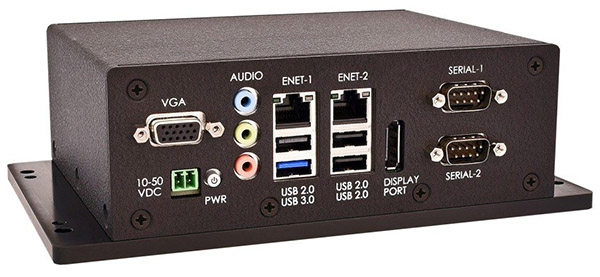By George T Hilliard

Over the last few months, I’ve been writing articles about the various aspects of industrial embedded computing, and the systems that drive those application spaces. However, it makes sense to define what an industrial embedded computer actually is so we have a baseline for any future discussions.
Using a basic definition, an industrial embedded computer is one that’s not intended to be a consumer device, even though it may share some of the same features, I/O, or basic functionality. For example, while each may be designed with an Intel-based microprocessor, the solution inside the industrial embedded box can generally withstand higher and/or lower temperatures through the use of embedded SKUs with more robust thermal management. Both may run some version of the Windows operating system (OS), but the OS inside the industrial computer typically comes from the embedded or IoT variants so unneeded functionality can be removed and the filesystem locked down to the specific application; Solitaire should not even be a temptation for a machine operator.
An industrial embedded computer, unlike your typical desktop computer, is designed specifically to be used in harsh environments, meaning it must be able to operate across a wide temperature range, withstand higher levels of shock and vibration, and so on. To accommodate this, you will most often see components soldered directly onto a pc board as opposed to sitting in sockets. In some cases, the industrial embedded computer is rack-mounted or resides inside a self-contained box for added protection. It may also offer different degrees of redundancy, including its power supplies.
Industrial Embedded Applications
Your end “industrial” application may be along the lines of environment monitoring and control, energy and utilities, or manufacturing automation, but the basic requirements for industrial features and durability are similar. These features may include remote sensing, energy management; humidity, particulate and radiation monitoring/control; shock/vibration sensing and measurement; and connection to custom end devices using WiFi or cellular, like those used in agricultural environments for example.
Industrial embedded computers typically align with industry standards for temperature ranges (-40°C to +85°C is typical) and shock and vibration, where a standard like IEC 68-2-27 looks at various aspects of shock in industrial equipment. In most cases, it refers to infrequent, non-repetitive mechanical shocks.
“Dependability” is a term that’s often thrown about when discussing industrial platforms, but it’s more subjective. Dependability can incorporate other aspects, like availability. High reliability, on the other hand, generally refers to a system that has a very high rate of uptime. Security and maintainability are sometimes lumped into the dependability category as well. In certain situations, software security and availability could also be included. Most OEMs have their own measuring stick for these features, which usually are based on customer requirements.

One platform that meets most of the requirements outlined above is the WINSYSTEMS SYS-405Q. This rugged industrial system, which is based on Intel’s quad-core Atom E3845 microprocessor, can operate at extended temperatures (-40°C to +85°C) without needing a fan or heat-pipe. As a complete system, the SYS-405Q is protected by a small, rugged lightweight aluminum enclosure, which provides ample strength without adding unnecessary weight to the system. The box measures 8 by 5 by 2.5 in. and weighs just 2.65 lbs.
A feature that separates the SYS-405Q from the competition is its wealth of I/O. The system includes dual Ethernet, dual MiniPCIe, USB 3.0, serial ports with RS-232/422/485, and two independent displays through DisplayPort, and/or analog VGA. While the standard reference design includes all this connectivity, features can be added or removed as necessary to fit customers’ performance specifications, making a semi-custom design easier without the expense and time investment of a full-custom designed product.
